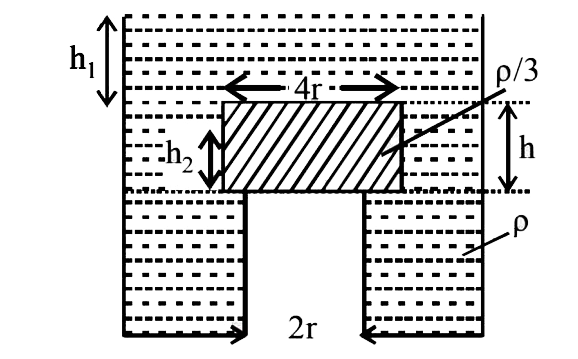A long cylindrical vessel has a small hole of diameter D at its bottom. This vessel can be lowered vertically in water to a depth h without any water entering the vessel. Given : A=surface tension, B=density of liquid, C=acceleration due to gravity. The value of h is
The correct Answer is:D
Step by step video, text & image solution for A long cylindrical vessel has a small hole of diameter D at its bottom. This vessel can be lowered vertically in water to a depth h without any water entering the vessel. Given : A=surface tension, B=density of liquid, C=acceleration due to gravity. The value of h is by Physics experts to help you in doubts & scoring excellent marks in Class 12 exams.
Topper's Solved these Questions
- BOOK - ALLENCHAPTER - RACEEXERCISE - Basic Maths (Thermal Physics) (Temperature scales & thermal expansion)13videos
RACE
- BOOK - ALLENCHAPTER - RACEEXERCISE - Basic Maths (Thermal Physics) (Calorimetry)13videos
RACE
- BOOK - ALLENCHAPTER - RACEEXERCISE - Basic Maths (Properties of Matter & Fluid Mechanics)(Hydrostatics)20videos
RACE
- BOOK - ALLENCHAPTER - NEWTONS LAWS OF MOTIONEXERCISE - EXERCISE-III28videos
NEWTONS LAWS OF MOTION
- BOOK - ALLENCHAPTER - SIMPLE HARMONIC MOTIONEXERCISE - Example1videos
SIMPLE HARMONIC MOTION
Similar Questions
A large vessel having a very small circular hole of diameter 1 mm at the bottom is filled with water. Up to what maximum height (in cm) water can be filled in the vessel so that there is no leakage? [surface tension of water 7.5×10−2Nm−1andg=10ms−2]
View SolutionWhen water is filled caerfully in a glass . One can fill it to a height h above the rim of glass due to the surface tension of water . To calculate h just before water starts flowing model the shape of the water above the rim as a disc of thickness h having semicircular edges as shown achematically in the figure When the pressure of water at the bottom of this disc exceeds what can be withstood due to the surface lension , the water surface breaks near the rim and water starts flowing form there if the density of water, its surface tension and the acceleration due to gravity are 103kgm−3,0.07Nm−1and10ms−2 , respectively, the value of h (in mm) is _________
 View Solution
View Solution
Knowledge Check
- Question 1 - Select One
A long cylinderical glass vessel has a small hole of radius r at its bottom. The depth to which the vessel can be lowered vertically in a deep water (surface tension S) without any water entering inside is
A4SrρgB3SrρgC2SrρgDSrρg - Question 2 - Select One
A vessel has a small hole at its bottom. If water can be poured into it upto a height of 7 cm without leakage (g=10ms−2) the radius of the hole is (surface tension of water is 0.7Nm−1)
A2 mmB0.2 mmC0.1 mmD0.4 mm - Question 3 - Select One
A cylinderical vessel is filled with water up to height H. A hole is bored in the wall at a depth h from the free surface of water. For maximum range h is equal to
AH/4BH/2C3H/4DH
The bottom of a cylindrical vessel has a circlular hole of radius r and at depth h below the water] level. If the diameter of the vessel is D, the find then speed with which the water level in the] vessel drops.
View SolutionThe absolute pressure at a depth h below the surface of a liquid of density ρ is [Given Pa = atmospheric pressure, g = acceleration due to gravity]
View SolutionA cylindrical tank has a hole of diameter 2r in its bottom. The hole is covered wooden cylindrical block of diameter 4r, height h and density ρ/3.

Situation I: Initially, the tank is filled with water of density ρ to a height such that the height of water above the top of the block is h1 (measured from the top of the block).
Situation II: The water is removed from the tank to a height h2 (measured from the bottom of the block), as shown in the figure. The height h2 is smaller than h (height of the block) and thus the block is exposed to the atmosphere.
Find the minimum value of height h1 (in situation 1), for which the block just starts to move up?View SolutionA cylindrical tank has a hole of diameter 2r in its bottom. The hole is covered wooden cylindrical block of diameter 4r, height h and density ρ/3.

Situation I: Initially, the tank is filled with water of density ρ to a height such that the height of water above the top of the block is h1 (measured from the top of the block).
Situation II: The water is removed from the tank to a height h2 (measured from the bottom of the block), as shown in the figure. The height h2 is smaller than h (height of the block) and thus the block is exposed to the atmosphere.
In situation 2, if h2 is further decreased, thenView SolutionSurface tension arises from the cohesive force between the surface molecules. Interplay between cohesion and adhesion force make the surface inclined at acute or obtuse angle with the contacting solid surfaces. This causes a capillary rise (or fail) given as h=2Tcosθρgr, where θ= angle of contact T= surface tension ρ= density of the liquid, g= acceleration due to gravity and r= radius of the capillary tube.
Q. If the vessel accelerates up, capillary rise,View Solution

